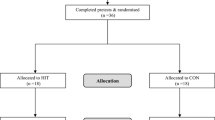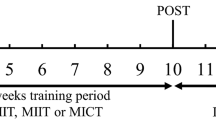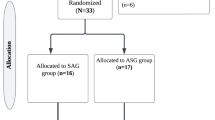Abstract
Background
The impact of HIV duration on exercise adaptations has not yet been studied. Moreover, the age at which subjects living with HIV are the most responsive to exercise is not clear.
AIMS
Investigate the effect of a mixed exercise training program on physical performance changes in individuals living with HIV and explore if age or HIV duration influence these adaptations in men.
Methods
In this feasibility study, participants followed a 12-week mixed exercise training program, three times/week, 45 min/session. Physical performance including functional capacities (normal 4-m walking test, 6min walking test), grip strength (hand dynamometer), muscle power, body composition (android and gynoid fat masses, appendicular lean mass) were evaluated pre- and post-intervention. Subgroup analysis according to the median age of the participants (age<50yrs vs. age≥50yrs) and median HIV duration (HIV<20yrs vs. HIV≥20yrs) were performed in men.
Results
A total of 27 participants (age: 54.5±6.8yrs, men: 85%; HIV duration: 19.3±7.6yrs) were included. At the end of the intervention, significant increases compared to baseline were seen in grip strength (p=0.017), leg power (p<0.001), normal walking speed (p<0.001) and 6-min walking distance (p=0.003). Following the intervention, parameters improved similarly in both age groups. However improvement was greater in those with HIV>20yrs than those with a shorter infection duration, with change (%) on total (p<0.001), android (p=0.02), and gynoid (p=0.05) fat masses as well as appendicular lean mass index (p=0.03).
Conclusion
Mixed exercise training seems to be an effective intervention to improve physical performance in individuals living with HIV. In addition, this study suggests that neither age nor HIV duration has influence on the effect of mixed training in this population.
Similar content being viewed by others
References
Hawton, A., et al., The impact of social isolation on the health status and health-related quality of life of older people. Qual Life Res, 2011. 20(1): p. 57–67.
Bouchard, D.R. and I. Janssen, Dynapenic-obesity and physical function in older adults. J Gerontol A Biol Sci Med Sci, 2010. 65(1): p. 71–7.
Rajasuriar, R., et al., Major health impact of accelerated aging in young HIV-infected individuals on antiretroviral therapy. Aids, 2017. 31(10): p. 1393–1403.
Greene, M., et al., Geriatric Syndromes in Older HIV-Infected Adults. J Acquir Immune Defic Syndr, 2015. 69(2): p. 161–7.
McMillan, J.M., et al., An Emerging Concern-High Rates of Frailty among Middle-aged and Older Individuals Living with HIV. Can Geriatr J, 2019. 22(4): p. 190–198.
Guaraldi, G., et al., The Interplay Between Age and Frailty in People Living With HIV: Results From an 11-Year Follow-up Observational Study. Open Forum Infect Dis, 2019. 6(5): p. ofz199.
Desquilbet, L., et al., HIV-1 infection is associated with an earlier occurrence of a phenotype related to frailty. J Gerontol A Biol Sci Med Sci, 2007. 62(11): p. 1279–86.
Compston, J., HIV infection and osteoporosis. Bonekey Rep, 2015. 4: p. 636.
Mhariwa, P.C., et al., The relationship between lower limb muscle strength and lower extremity function in HIV disease. S Afr J Physiother, 2017. 73(1): p. 360.
Bailin, S.S., et al., Obesity and Weight Gain in Persons with HIV. Curr HIV/AIDS Rep, 2020. 17(2): p. 138–150.
Lake, J.E., The Fat of the Matter: Obesity and Visceral Adiposity in Treated HIV Infection. Curr HIV/AIDS Rep, 2017. 14(6): p. 211–219.
Langhammer, B., A. Bergland, and E. Rydwik, The Importance of Physical Activity Exercise among Older People. Biomed Res Int, 2018. 2018: p. 7856823.
Buckinx, F. and M. Aubertin-Leheudre, Relevance to assess and preserve muscle strength in aging field. Prog Neuropsychopharmacol Biol Psychiatry, 2019: p. 109663.
Voigt, N., H. Cho, and R. Schnall, Supervised Physical Activity and Improved Functional Capacity among Adults Living with HIV: A Systematic Review. J Assoc Nurses AIDS Care, 2018. 29(5): p. 667–680.
Dolan, S.E., et al., Effects of a supervised home-based aerobic and progressive resistance training regimen in women infected with human immunodeficiency virus: a randomized trial. Arch Intern Med, 2006. 166(11): p. 1225–31.
Driscoll, S.D., et al., Effects of exercise training and metformin on body composition and cardiovascular indices in HIV-infected patients. Aids, 2004. 18(3): p. 465–73.
Dudgeon, W.D., et al., Moderate-Intensity Exercise Improves Body Composition and Improves Physiological Markers of Stress in HIV-Infected Men. Isrn aids, 2012. 2012: p. 145127.
Farinatti, P.T., et al., Effects of a supervised exercise program on the physical fitness and immunological function of HIV-infected patients. J Sports Med Phys Fitness, 2010. 50(4): p. 511–8.
Fillipas, S., et al., A six-month, supervised, aerobic and resistance exercise program improves self-efficacy in people with human immunodeficiency virus: a randomised controlled trial. Aust J Physiother, 2006. 52(3): p. 185–90.
Ogalha, C., et al., A randomized, clinical trial to evaluate the impact of regular physical activity on the quality of life, body morphology and metabolic parameters of patients with AIDS in Salvador, Brazil. J Acquir Immune Defic Syndr, 2011. 57 Suppl 3: p. S179–85.
Pérez-Moreno, F., et al., Benefits of exercise training in Spanish prison inmates. Int J Sports Med, 2007. 28(12): p. 1046–52.
Mayo, N.E., M.J. Brouillette, and L.K. Fellows, Understanding and optimizing brain health in HIV now: protocol for a longitudinal cohort study with multiple randomized controlled trials. BMC Neurol, 2016. 16: p. 8.
Eldridge, S.M., et al., CONSORT 2010 statement: extension to randomised pilot and feasibility trials. Pilot Feasibility Stud, 2016. 2: p. 64.
Kaur, N., et al., Feasibility and potential benefits of a structured exercise program on cognitive performance in HIV. AIDS Care, 2021: p. 1–9.
Thomas, S., J. Reading, and R.J. Shephard, Revision of the Physical Activity Readiness Questionnaire (PAR-Q). Can J Sport Sci, 1992. 17(4): p. 338–45.
Buckinx, F., et al., Muscle adaptation in response to a high-intensity interval training in obese older adults: effect of daily protein intake distribution. Aging Clin Exp Res, 2019. 31(6): p. 863–874.
F, B., et al., High intensity interval training combined with L-citrulline supplementation: Effects on physical performance in healthy older adults. Exp Gerontol, 2020. 140: p. 111036.
Baumgartner, R.N., et al., Epidemiology of sarcopenia among the elderly in New Mexico. Am J Epidemiol, 1998. 147(8): p. 755–63.
Blew, R.M., et al., Standardizing evaluation of pQCT image quality in the presence of subject movement: qualitative versus quantitative assessment. Calcif Tissue Int, 2014. 94(2): p. 202–11.
Doube, M., et al., BoneJ: free and extensible bone image analysis in ImageJ. Bone, 2010. 47(6): p. 1076–1079.
Frank-Wilson, A.W., et al., Measurement of muscle and fat in postmenopausal women: precision of previously reported pQCT imaging methods. Bone, 2015. 75: p. 49–54.
Clark, B.C. and T.M. Manini, Functional consequences of sarcopenia and dynapenia in the elderly. Curr Opin Clin Nutr Metab Care, 2010. 13(3): p. 271–6.
Tremblay, M.S., et al., Physical activity assessment options within the context of the Canadian Physical Activity, Fitness, and Lifestyle Appraisal. Can J Appl Physiol, 2001. 26(4): p. 388–407.
Hurst, C., et al., Short- and long-term reliability of leg extensor power measurement in middle-aged and older adults. J Sports Sci, 2018. 36(9): p. 970–977.
Burr, J.F., et al., The 6-minute walk test as a predictor of objectively measured aerobic fitness in healthy working-aged adults. Phys Sportsmed, 2011. 39(2): p. 133–9.
Andersson, M., et al., Measuring walking speed in COPD: test-retest reliability of the 30-metre walk test and comparison with the 6-minute walk test. Prim Care Respir J, 2011. 20(4): p. 434–40.
Wise, R.A. and C.D. Brown, Minimal clinically important differences in the six-minute walk test and the incremental shuttle walking test. Copd, 2005. 2(1): p. 125–9.
Cleland, B.T., H. Arshad, and S. Madhavan, Concurrent validity of the GAITRite electronic walkway and the 10-m walk test for measurement of walking speed after stroke. Gait Posture, 2019. 68: p. 458–460.
Bonato, M., et al., The Role of Physical Activity for the Management of Sarcopenia in People Living with HIV. Int J Environ Res Public Health, 2020. 17(4).
O’Brien, K.K., et al., Effectiveness of aerobic exercise for adults living with HIV: systematic review and meta-analysis using the Cochrane Collaboration protocol. BMC Infect Dis, 2016. 16: p. 182.
Oursler, K.K., et al., A pilot randomized aerobic exercise trial in older HIV-infected men: Insights into strategies for successful aging with HIV. PLoS One, 2018. 13(6): p. e0198855.
Jankowski, C.M., et al., Body Composition Changes in Response to Moderate- or High-Intensity Exercise Among Older Adults With or Without HIV Infection. J Acquir Immune Defic Syndr, 2020. 85(3): p. 340–345.
Smith, B.A., et al., Aerobic exercise: effects on parameters related to fatigue, dyspnea, weight and body composition in HIV-infected adults. Aids, 2001. 15(6): p. 693–701.
Oursler, K.K., et al., Association of age and comorbidity with physical function in HIV-infected and uninfected patients: results from the Veterans Aging Cohort Study. AIDS Patient Care STDS, 2011. 25(1): p. 13–20.
Gomes-Neto, M., et al., A systematic review of the effects of different types of therapeutic exercise on physiologic and functional measurements in patients with HIV/AIDS. Clinics (Sao Paulo), 2013. 68(8): p. 1157–67.
Grace, J.M., S.J. Semple, and S. Combrink, Exercise therapy for human immunodeficiency virus/AIDS patients: Guidelines for clinical exercise therapists. J Exerc Sci Fit, 2015. 13(1): p. 49–56.
Jaggers, J.R. and G.A. Hand, Health Benefits of Exercise for People Living With HIV: A Review of the Literature. Am J Lifestyle Med, 2016. 10(3): p. 184–192.
Wing, E.J., HIV and aging. Int J Infect Dis, 2016. 53: p. 61–68.
López-Otín, C., et al., The hallmarks of aging. Cell, 2013. 153(6): p. 1194–217.
Althoff, K.N., et al., Comparison of risk and age at diagnosis of myocardial infarction, end-stage renal disease, and non-AIDS-defining cancer in HIV-infected versus uninfected adults. Clin Infect Dis, 2015. 60(4): p. 627–38.
Rasmussen, L.D., et al., Time trends for risk of severe age-related diseases in individuals with and without HIV infection in Denmark: a nationwide population-based cohort study. Lancet HIV, 2015. 2(7): p. e288–98.
Ghidei, L., et al., Aging, antiretrovirals, and adherence: a meta analysis of adherence among older HIV-infected individuals. Drugs Aging, 2013. 30(10): p. 809–19.
Funding
Funding: This research did not receive any specific grant from funding agencies in the public, commercial, or not-for-profit sectors. FB and MAL are supported by FRQS.
Author information
Authors and Affiliations
Corresponding author
Additional information
Conflict of Interest: We have no Conflict of Interest.
Informed consent: All participants gave written informed consent.
Ethical Statement details: Full agreement with ethical standards.
Ethical approval: The ethics approval was obtained from the McGill University Health Centre (MUHC) and from the research ethics review committee at the Université du Québec à Montréal (UQAM).
Rights and permissions
About this article
Cite this article
Buckinx, F., Granet, J., Bass, A. et al. Effect of a 12-Week Mixed Training on Body Quality in People Living with HIV: Does Age and HIV Duration Matter?. J Frailty Aging 11, 426–433 (2022). https://doi.org/10.14283/jfa.2022.56
Received:
Accepted:
Published:
Issue Date:
DOI: https://doi.org/10.14283/jfa.2022.56




